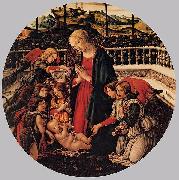
Oil On
Canvas, Real Flavor of Old Masters
|
Francisco de Zurbaran
|
|||
|
|
|||
| 1598-1664 Spanish Francisco de Zurbaran Galleries Spanish baroque painter, active mainly at Llerena, Madrid, and Seville. He worked mostly for ecclesiastical patrons. His early paintings, including Crucifixion (1627; Art Inst., Chicago), St. Michael (Metropolitan Mus.), and St. Francis (City Art Museum, St. Louis), often suggest the austere simplicity of wooden sculpture. The figures, placed close to the picture surface, are strongly modeled in dramatic light against dark backgrounds, indicating the influence of Caravaggio. They were clearly painted as altarpieces or devotional objects. In the 1630s the realistic style seen in his famous Apotheosis of St. Thomas Aquinas (1631; Seville) yields to a more mystical expression in works such as the Adoration of the Shepherds (1638; Grenoble); in this decade he was influenced by Ribera figural types and rapid brushwork. While in Seville, Zurbur??n was clearly influenced by Velazquez. After c.1640 the simple power of Zurbaran work lessened as Murillo influence on his painting increased (e.g., Virgin and Child with St. John, Fine Arts Gall., San Diego, Calif.). There are works by Zurbar??n in the Hispanic Society of America, New York City; the National Gallery, Washington, D.C.; and the Philadelphia Museum of Art.. | |||
|
|
|||
|
|
Madonna with Child new3/Francisco de Zurbaran-445747.jpg Painting ID:: 29522 Visit European Gallery |
1658 Oil on canvas, 101 x 78 cm | |
Height Width |
INS/CM |
||
|
X |
|
||
|
|
|||
|
GIAMBONO, Michele
|
|||
|
|
|||
| Italian painter, Venetian school (known 1420-1462 in Venice) | |||
|
|
|||
|
|
Madonna with Child new16/GIAMBONO, Michele-262879.jpg Painting ID:: 41191 Visit European Gallery |
mk157 early 15th century tempera on wood | |
Height Width |
INS/CM |
||
|
X |
|
||
|
|
|||
|
Pietro Perugino
|
|||
|
|
|||
| Italian 1450-1523 Pietro Perugino Galleries Italian painter and draughtsman. He was active in Perugia, Florence and Rome in the late 15th century and early 16th. Although he is now known mainly as the teacher of Raphael, he made a significant contribution to the development of painting from the style of the Early Renaissance to the High Renaissance. The compositional model he introduced, combining the Florentine figural style with an Umbrian use of structure and space, was taken up by Raphael and became widely influential throughout Europe. | |||
|
|
|||
|
|
Madonna with Child new24/Pietro Perugino-733659.jpg Painting ID:: 83614 Visit European Gallery |
Date 1501(1501) Medium Oil on wood Dimensions Height: 70 cm (27.6 in). Width: 51 cm (20.1 in). cjr | |
Height Width |
INS/CM |
||
|
X |
|
||
|
|
|||
|
Francesco Botticini
|
|||
|
|
|||
| Florence 1446-1497 | |||
|
|
|||
|
|
Madonna with Child new25/Francesco Botticini-468996.jpg Painting ID:: 86279 Visit European Gallery |
1490(1490) Medium Oil on wood cyf | |
Height Width |
INS/CM |
||
|
X |
|
||
|
|
|||










